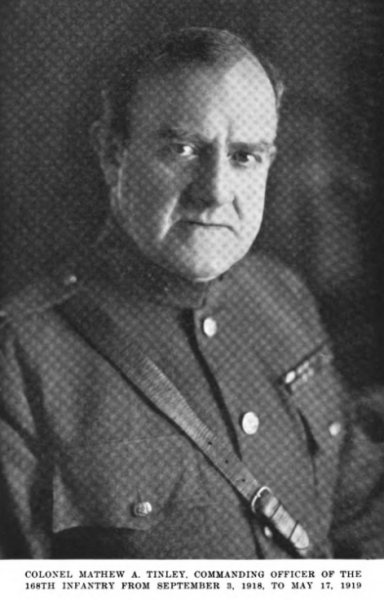
Mathew Adrian Tinley, physician and surgeon, retired Lieutenant General and Commander of the 34th Infantry Division was the first Commander of the Iowa Department of the American Legion.
Born on March 5, 1876, over a small grocery store in Council Bluffs, Mathew was one of 8 children of Mathew Hugh and Rose (Dolan) Tinley, both natives of Ireland. Mathew attended public schools in Council Bluffs, graduating from high school in 1894. Mathew carried papers, cared for a garden and herded cattle for spending money. His military career began with his participation in his high school's voluntary cadet company. Soon after graduation he joined the Dodge Light Guards, 3rd Iowa Infantry, as a Private. By the time of the Spanish-American War in 1898, he had become First Sergeant of his company.
He began college at the University of Nebraska in 1894. In April of 1898 he dropped out of medical school as he was called to active duty for the Spanish American War.
After training in Des Moines he was sent to the Philippine Islands as a Second Lieutenant with the 51st Iowa Volunteer Infantry. He returned as a First Lieutenant. Upon return, LT Tinley was mustered out of the active duty. Before going back to the National Guard, he earned his Captain‘s bars.
He resumed his medical education and graduated in 1902 from the University of Nebraska. He pursued postgraduate work in New York City, specializing in obstetrics. After further studies, he began medical practice at Jennie Edmundson Hospital in Council Bluffs.
Captain Tinley was promoted to Major, and given command of the 3rd Battalion of his Regiment. He left his medical practice to serve for a short time on the Mexican border as Lt. Colonel with the 3rd Iowa Infantry in February 1917.
In August of 1917, he was in Europe with the 42nd Rainbow Division. In October 1917, he was promoted to Colonel and placed in command of the 168th Infantry Regiment of the 42nd Division. After nearly two years in the expeditionary force and in occupation of Germany, Colonel Tinley returned in May of 1919. On July 7, 1921 he was given Command of the 67th Infantry Brigade as Brigadier General. He was promoted to Major General and given command of the 34th Division in 1924.
MG Tinley combined a distinguished military career with practice of medical profession in Council Bluffs. Always known as "Dr. Mat," he probably was the only Iowa Army combat officer who was simultaneously a practicing physician. His service spanned more than 45 years, with almost four years of this period in Federal service
At one time, he was chief of staff of Jennie Edmundson Hospital in Council Bluffs, and until her death, had been associated in medical practice with his sister, the late Dr. Mary Tinley. He retired from medical practice in 1953.
LTG Tinley’s military career ended as a three-star general, and he came out of retirement in 1940 to head the Iowa State Guard. His service medals and decorations received were: Distinguished Service Spanish War Service Medal, Philippine Congressional Medal, Philippine Campaign Medal, Mexican Border Service Medal, Victory Medal with one silver star and five bronze stars and the following clasps: Champagne, Aisen-Marne, Meuse-Argonne, Saint Mihiel, Chateau Thierry, Defensive Sector, also the French Legion of Honor, Officer, with Rosette, and the Croix-De-Guerre, with Gold Star. On August 2, 1938 he was awarded a special medal by the state of Iowa in recognition of long service in the Iowa National Guard; commanded the Iowa National Guard troops during the "farm strike" disorders in northwest Iowa in 1933 and for this duty received the medal of the United States Flag Association, given annually for law enforcement.
LTG Tinley was elected Sep 4, 1919 as the first Commander of the Iowa Department of the American Legion. Not much was found about the time LTG Tinley was Department Commander. Swisher's book "The American Legion in Iowa 1919-1929" does not say much about that first year. It does state that Tinley was selected as chairman of the temporary executive committee for the period between the St Louis caucus on May 8-10 and the first Iowa convention on September 4. That would have put him in charge of that first convention as well as being the first elected Commander.
Swisher's book states on page 70 that "This convention is significant in the history of the Legion in that it perfected a State organization at a very early date. It set up standards, outlined plans and established ideals which have been followed and maintained in the later conventions, and have been important in placing Iowa in the lead in Legion activities."
I think it can be safely said that Tinley's leadership provided the solid grounding for the work of that convention and that his year of leadership as Commander was devoted to spreading the word of the formation of The American Legion throughout Iowa. On page 71 of Swisher's book, it is stated that by the second convention, the one where Tinley presided as Commander, Iowa contained 542 posts with 37,299 members. To have accomplished that growth in the 16 months between May, 1919 and September, 1920 is a tribute to his leadership and ability to "speak the word" of The American Legion.
A Democrat, he was nominated by the Delegation of Iowa to the Democratic National Convention, for the office of Vice President in 1932. He withdrew to make way for Texan John Nance Garner.
Mathew Adrian Tinley died at Council Bluffs on March 11, 1956.
View more history for Post - Department Headquarters in Des Moines, Iowa
